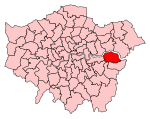Crossness Sewage Treatment Works
London water infrastructureSewage treatment plants in the United KingdomSewerageThames Water

The Crossness Sewage Treatment Works is a sewage treatment plant located at Crossness in the London Borough of Greenwich. It was opened in 1865 and is Europe's second largest sewage treatment works, after its counterpart Beckton Sewage Treatment Works located north of the river. Crossness treats the waste water from the Southern Outfall Sewer serving South and South East London, and is operated by Thames Water. The treated effluent from the plant is discharged into the River Thames at the eastern end of the site.
Excerpt from the Wikipedia article Crossness Sewage Treatment Works (License: CC BY-SA 3.0, Authors, Images).Crossness Sewage Treatment Works
Bazalgette Way, London
Geographical coordinates (GPS) Address External links Nearby Places Show on map
Geographical coordinates (GPS)
| Latitude | Longitude |
|---|---|
| N 51.5054 ° | E 0.14202 ° |
Address
Crossness Sewage Treatment Works
Bazalgette Way
SE2 9AR London (London Borough of Bexley)
England, United Kingdom
Open on Google Maps









